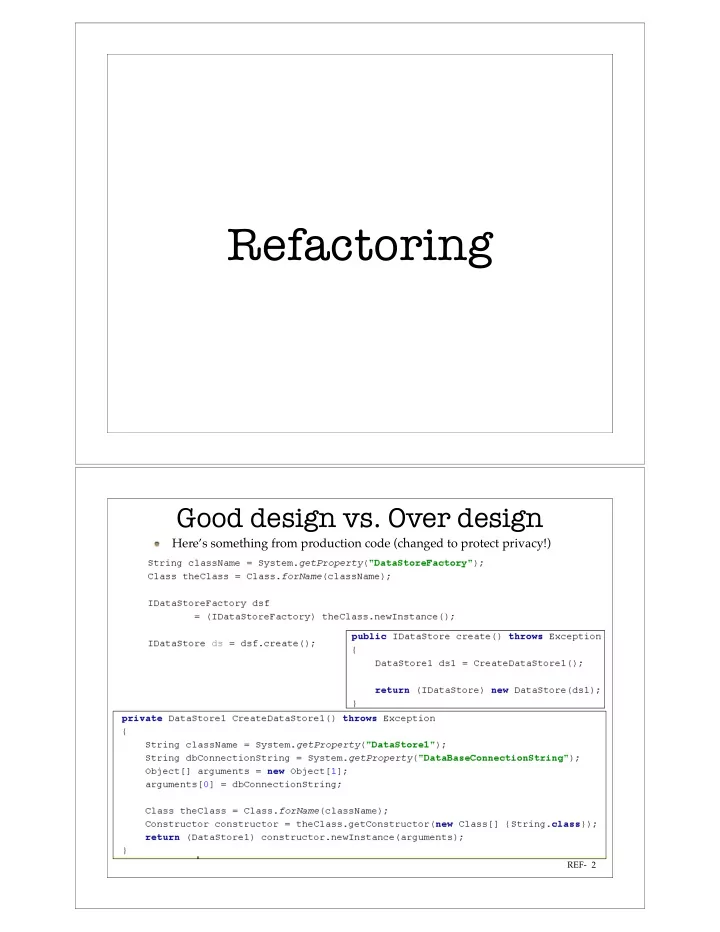

Refactoring Good design vs. Over design Here’s something from production code (changed to protect privacy!) REF- 2
Do you see the smell in that code? Not quite obvious at first sight May make sense if extensibility is needed But, there were exactly one implementation of each interface (one factory, one data source, etc). How about the following: REF- 3 My Code that Smells Let’s start with an example Here is code that works What do you think about it? REF- 4
From Writing to Coding… William Zinsser Wrote “On Writing Well” 25 years ago! He gives good principles for writing well These principles apply to programming as much as writing non-fiction Simplicity Clarity Brevity Humanity REF- 5 Perfection REF- 6
Code Quality REF- 7 Why? “Design, rather than occurring all up-front, occurs continuously during development.” If the code is hard to understand, it is hard to Maintain improve Work with for evolutionary design REF- 8
What’s Refactoring? “Art of improving the design of existing code” “A process of changing a software system in such a way that it does not alter the external behavior of the code yet improves its internal structure” REF- 9 But, again…? Why fix what’s not broken? A software module Should function its expected functionality It exists for this It must be affordable to change It will have to change over time, so it better be cost effective Must be easier to understand Developers unfamiliar with it must be able to read and understand it REF- 10
You're not Refactoring if… You are adding new functionality Fixing bugs Making new design enhancements Throwing away the ?#$*! code and rewriting Making too many changes all at once REF- 11 What’s needed before refactoring? Anytime we touch code, we may break things (inadvertently) You don’t want one step forward and ten steps backward Before you refactor, make sure you have solid automated self-checking unit tests for your code Approach refactoring in small steps so it is easy to find bugs or mistakes you introduce REF- 12
Points to Ponder Cohesion Encapsulation Don’t Repeat Yourself (DRY) Tell Don’t Ask (TDA) REF- 13 A word of Caution Some of the techniques, you will find, are quite opposing to other techniques Sometimes the wisdom tells you to go right, sometimes it tells you to go left You need to decide which is the right approach when REF- 14
Smells to take note of "Smell check" your code! Duplication Unnecessary complexity Useless or misleading comments Long classes Long methods Poor names for variables, methods, classes Code that’s not used Improper use of inheritance … REF- 15 Exercise on Refactor Let’s deodorize my code! REF- 16
Overview: Refactoring Techniques Several refactoring techniques exist You modify the code any time you think it will lead to Clarity Simplicity Better understanding REF- 17 Composing Methods Long methods are problem Lack cohesion Too complex Refactoring techniques Extract Method Inline Method Replace Temp with a Query Introduce Explaining Variable Replace Method with Method object Substitute Algorithm REF- 18
Move Features Between Objects Where does this method go? Often it is the (victim) class that's visible in the IDE? Hard to get it right the first time Refactoring techniques Move Method Move Field Extract Class Inline Class Hide Delegate Remove Middle Man Introduce Foreign Method Introduce Local Extension REF- 19 Many more… Many more refactoring techniques than we can cover here Refer to Martin Fowler’s celebrated book in references REF- 20
To refactor or not to refactor? To Anytime you can cleanup the code To make it readable, understandable, simpler You are convinced about the change Before adding a feature or fixing a bug After adding a feature or fixing a bug Not to Not for the sake of refactoring When the change will affect too many things When change may render application unusable In the middle of adding a feature or fixing a bug REF- 21 When you don’t have unit tests to support your change
Recommend
More recommend